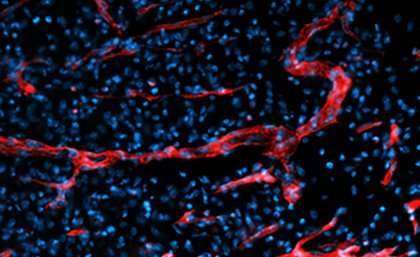A blood vessel within a wound. Credit: University of Queensland
The discovery of a regenerative stem cell active in human blood vessels could help patients with diabetes and cardiovascular disease.
The University of Queensland Centre for Clinical Research's Dr Jatin Patel said the finding overcomes one of the biggest hurdles in understanding cardiovascular disease and how wounds heal.
"It will allow research to focus on improving the use of blood vessels which are often under strain in patients with conditions like cardiovascular disease and diabetes," Dr Patel said.
He has been at the forefront of a skin vascular research program led by UQ's Associate Professor Kiarash Khosrotehrani investigating rare cells that bear the major responsibility of forming and maintaining our blood vessels.
"There had been a lot of conjecture about how blood vessels regenerate in the adult system," Dr Patel said.
"Research had never been able to show if stem cells actually exist in the vascular system but now we can definitively say they do.
"It was believed that if these stem cells did exist that they must originate from bone marrow, but we've determined they actually reside within a person's own blood vessels.
"They have a molecular signature that makes them unique in their function and ability from the surrounding cells."
When a patient has a wound or an injury, the research has found these stem cells work to regenerate the blood vessels, bringing in oxygen, and ultimately close over the wound.
"Unfortunately for patients prone to serious wounds, like diabetic patients with poor circulation, amputations are too frequently an outcome because there is little alternative, Dr Patel said.
"Now we know these regenerative cells exist, we want to develop therapies to speed up the healing process to allow wounds to close over and avoid amputations.
"We'll be looking at how to potentially take very young cells from the placenta, and inject them into older patients to help boost their regenerative capacity.
"This discovery has really clarified the fundamentals of vascular biology so we can take it to the next step and help patients."
Provided by University of Queensland





















